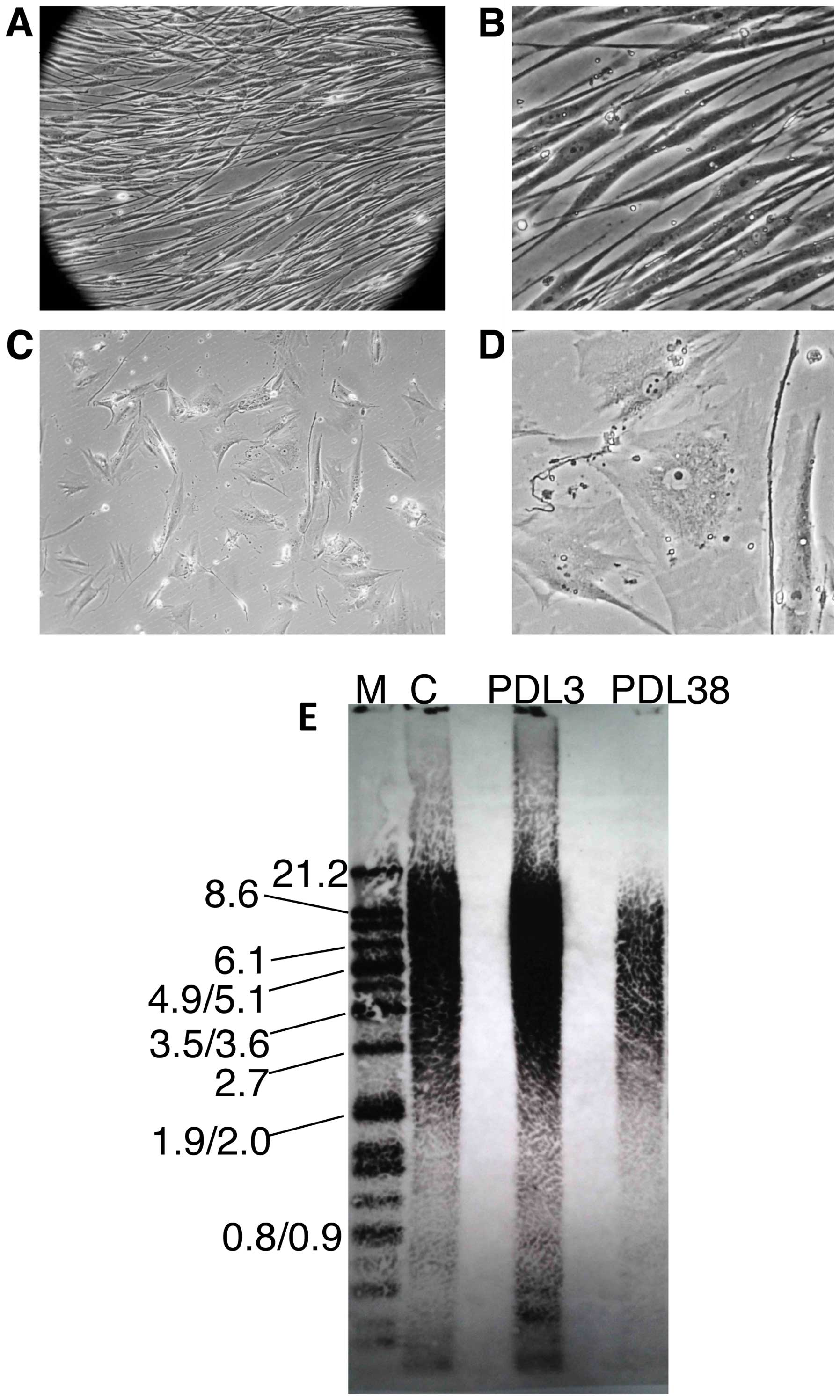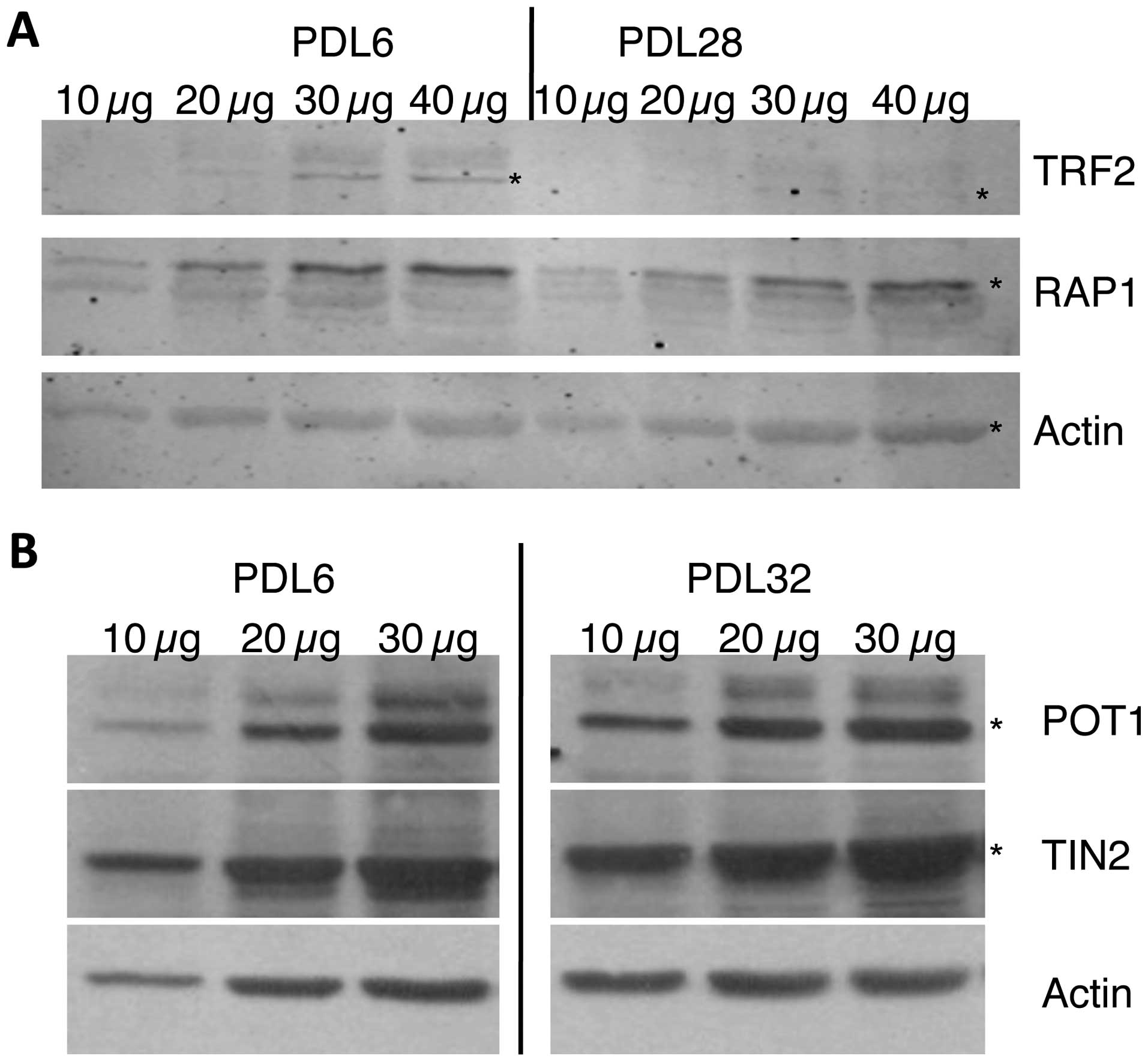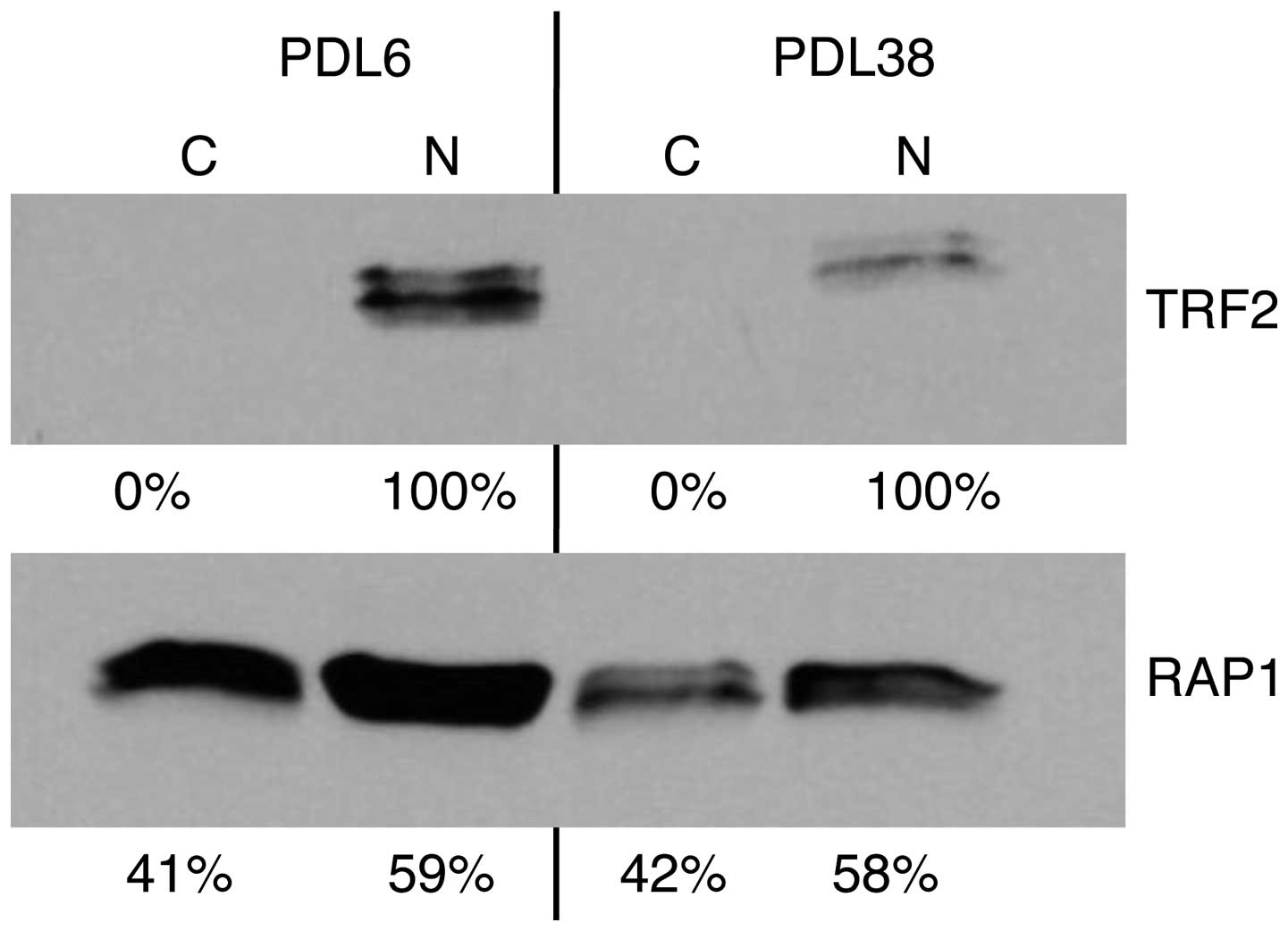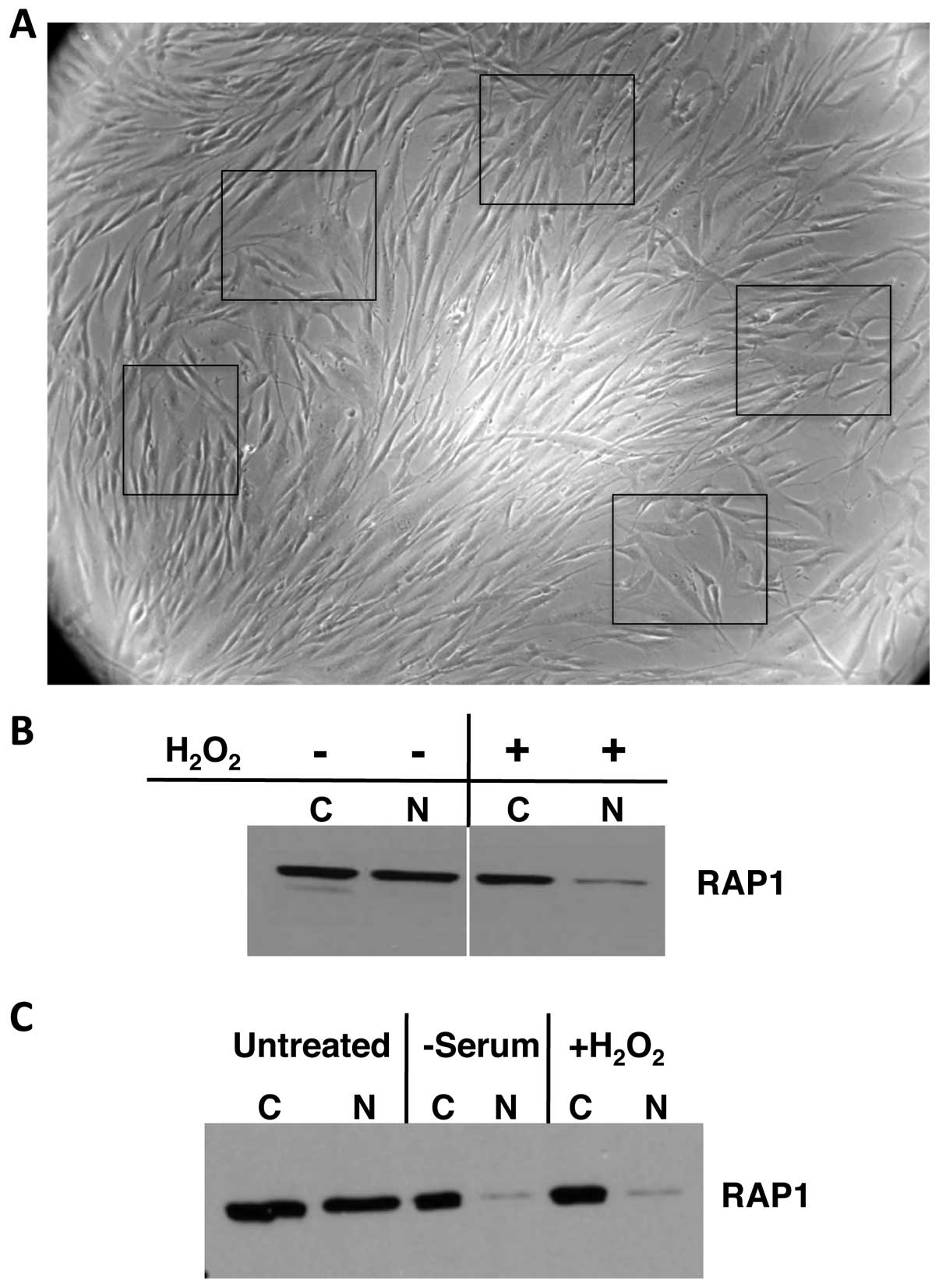|
1
|
Campisi J: Aging, cellular senescence, and
cancer. Annu Rev Physiol. 75:685–705. 2013. View Article : Google Scholar : PubMed/NCBI
|
|
2
|
Blackburn EH: Telomere states and cell
fates. Nature. 408:53–56. 2000. View
Article : Google Scholar : PubMed/NCBI
|
|
3
|
de Lange T: Shelterin: The protein complex
that shapes and safeguards human telomeres. Genes Dev.
19:2100–2110. 2005. View Article : Google Scholar : PubMed/NCBI
|
|
4
|
Bianchi A, Smith S, Chong L, Elias P and
de Lange T: TRF1 is a dimer and bends telomeric DNA. EMBO J.
16:1785–1794. 1997. View Article : Google Scholar : PubMed/NCBI
|
|
5
|
Broccoli D, Smogorzewska A, Chong L and de
Lange T: Human telomeres contain two distinct Myb-related proteins,
TRF1 and TRF2. Nat Genet. 17:231–235. 1997. View Article : Google Scholar : PubMed/NCBI
|
|
6
|
Court R, Chapman L, Fairall L and Rhodes
D: How the human telomeric proteins TRF1 and TRF2 recognize
telomeric DNA: A view from high-resolution crystal structures. EMBO
Rep. 6:39–45. 2005. View Article : Google Scholar : PubMed/NCBI
|
|
7
|
Palm W and de Lange T: How shelterin
protects mammalian telomeres. Annu Rev Genet. 42:301–334. 2008.
View Article : Google Scholar : PubMed/NCBI
|
|
8
|
Ancelin K, Brunori M, Bauwens S, Koering
CE, Brun C, Ricoul M, Pommier JP, Sabatier L and Gilson E:
Targeting assay to study the cis functions of human telomeric
proteins: Evidence for inhibition of telomerase by TRF1 and for
activation of telomere degradation by TRF2. Mol Cell Biol.
22:3474–3487. 2002. View Article : Google Scholar : PubMed/NCBI
|
|
9
|
Sfeir A, Kosiyatrakul ST, Hockemeyer D,
MacRae SL, Karlseder J, Schildkraut CL and de Lange T: Mammalian
telomeres resemble fragile sites and require TRF1 for efficient
replication. Cell. 138:90–103. 2009. View Article : Google Scholar : PubMed/NCBI
|
|
10
|
Celli GB and de Lange T: DNA processing is
not required for ATM-mediated telomere damage response after TRF2
deletion. Nat Cell Biol. 7:712–718. 2005. View Article : Google Scholar : PubMed/NCBI
|
|
11
|
Li B, Oestreich S and de Lange T:
Identification of human Rap1: Implications for telomere evolution.
Cell. 101:471–483. 2000. View Article : Google Scholar : PubMed/NCBI
|
|
12
|
Xin H, Liu D, Wan M, Safari A, Kim H, Sun
W, O'Connor MS and Songyang Z: TPP1 is a homologue of ciliate
TEBP-beta and interacts with POT1 to recruit telomerase. Nature.
445:559–562. 2007. View Article : Google Scholar : PubMed/NCBI
|
|
13
|
Liu D, Safari A, O'Connor MS, Chan DW,
Laegeler A, Qin J and Songyang Z: PTOP interacts with POT1 and
regulates its localization to telomeres. Nat Cell Biol. 6:673–680.
2004. View
Article : Google Scholar : PubMed/NCBI
|
|
14
|
Takai KK, Hooper S, Blackwood S, Gandhi R
and de Lange T: In vivo stoichiometry of shelterin components. J
Biol Chem. 285:1457–1467. 2010. View Article : Google Scholar : PubMed/NCBI
|
|
15
|
Baumann P and Cech TR: Pot1, the putative
telomere end-binding protein in fission yeast and humans. Science.
292:1171–1175. 2001. View Article : Google Scholar : PubMed/NCBI
|
|
16
|
Hockemeyer D, Palm W, Else T, Daniels JP,
Takai KK, Ye JZ, Keegan CE, de Lange T and Hammer GD: Telomere
protection by mammalian Pot1 requires interaction with Tpp1. Nat
Struct Mol Biol. 14:754–761. 2007. View
Article : Google Scholar : PubMed/NCBI
|
|
17
|
Churikov D and Price CM: Pot1 and cell
cycle progression cooperate in telomere length regulation. Nat
Struct Mol Biol. 15:79–84. 2008. View
Article : Google Scholar : PubMed/NCBI
|
|
18
|
Guo X, Deng Y, Lin Y, Cosme-Blanco W, Chan
S, He H, Yuan G, Brown EJ and Chang S: Dysfunctional telomeres
activate an ATM-ATR-dependent DNA damage response to suppress
tumorigenesis. EMBO J. 26:4709–4719. 2007. View Article : Google Scholar : PubMed/NCBI
|
|
19
|
Wang F, Podell ER, Zaug AJ, Yang Y, Baciu
P, Cech TR and Lei M: The POT1-TPP1 telomere complex is a
telomerase processivity factor. Nature. 445:506–510. 2007.
View Article : Google Scholar : PubMed/NCBI
|
|
20
|
Houghtaling BR, Cuttonaro L, Chang W and
Smith S: A dynamic molecular link between the telomere length
regulator TRF1 and the chromosome end protector TRF2. Curr Biol.
14:1621–1631. 2004. View Article : Google Scholar : PubMed/NCBI
|
|
21
|
Ye JZ, Donigian JR, van Overbeek M, Loayza
D, Luo Y, Krutchinsky AN, Chait BT and de Lange T: TIN2 binds TRF1
and TRF2 simultaneously and stabilizes the TRF2 complex on
telomeres. J Biol Chem. 279:47264–47271. 2004. View Article : Google Scholar : PubMed/NCBI
|
|
22
|
Kim SH, Beausejour C, Davalos AR, Kaminker
P, Heo SJ and Campisi J: TIN2 mediates functions of TRF2 at human
telomeres. J Biol Chem. 279:43799–43804. 2004. View Article : Google Scholar : PubMed/NCBI
|
|
23
|
Chen LY, Liu D and Songyang Z: Telomere
maintenance through spatial control of telomeric proteins. Mol Cell
Biol. 27:5898–5909. 2007. View Article : Google Scholar : PubMed/NCBI
|
|
24
|
Sfeir A, Kabir S, van Overbeek M, Celli GB
and de Lange T: Loss of Rap1 induces telomere recombination in the
absence of NHEJ or a DNA damage signal. Science. 327:1657–1661.
2010. View Article : Google Scholar : PubMed/NCBI
|
|
25
|
Martinez P, Thanasoula M, Carlos AR,
Gómez-López G, Tejera AM, Schoeftner S, Dominguez O, Pisano DG,
Tarsounas M and Blasco MA: Mammalian Rap1 controls telomere
function and gene expression through binding to telomeric and
extratelomeric sites. Nat Cell Biol. 12:768–780. 2010. View Article : Google Scholar : PubMed/NCBI
|
|
26
|
Bae NS and Baumann P: A RAP1/TRF2 complex
inhibits nonhomologous end-joining at human telomeric DNA ends. Mol
Cell. 26:323–334. 2007. View Article : Google Scholar : PubMed/NCBI
|
|
27
|
Sarthy J, Bae NS, Scrafford J and Baumann
P: Human RAP1 inhibits non-homologous end joining at telomeres.
EMBO J. 28:3390–3399. 2009. View Article : Google Scholar : PubMed/NCBI
|
|
28
|
Yang D, Xiong Y, Kim H, He Q, Li Y, Chen R
and Songyang Z: Human telomeric proteins occupy selective
interstitial sites. Cell Res. 21:1013–1027. 2011. View Article : Google Scholar : PubMed/NCBI
|
|
29
|
Teo H, Ghosh S, Luesch H, Ghosh A, Wong
ET, Malik N, Orth A, de Jesus P, Perry AS, Oliver JD, et al:
Telomere-independent Rap1 is an IKK adaptor and regulates
NF-kappaB-dependent gene expression. Nat Cell Biol. 12:758–767.
2010. View Article : Google Scholar : PubMed/NCBI
|
|
30
|
Hayflick L: Subculturing human diploid
fibroblast cultures. Tissue Culture Methods and Applications. Kruse
PF Jr and Patterson MK: Academic Press. (New York, NY). 220–223.
1973.
|
|
31
|
Grant JD, Broccoli D, Muquit M, Manion FJ,
Tisdall J and Ochs MF: Telometric: A tool providing simplified,
reproducible measurements of telomeric DNA from constant field
agarose gels. Biotechniques. 31:1314–1316, 1318. 2001.PubMed/NCBI
|
|
32
|
Méndez J and Stillman B: Chromatin
association of human origin recognition complex, cdc6, and
minichromosome maintenance proteins during the cell cycle: Assembly
of prereplication complexes in late mitosis. Mol Cell Biol.
20:8602–8612. 2000. View Article : Google Scholar : PubMed/NCBI
|
|
33
|
Abramoff MD, Magalhaes PJ and Ram SJ:
Image Processing with ImageJ. Biophoton Int. 11:36–42. 2004.
|
|
34
|
Xia Y, Shen S and Verma IM: NF-κB, an
active player in human cancers. Cancer Immunol Res. 2:823–830.
2014. View Article : Google Scholar : PubMed/NCBI
|
|
35
|
Soria-Valles C, Osorio FG,
Gutiérrez-Fernández A, De Los Angeles A, Bueno C, Menéndez P,
Martín-Subero JI, Daley GQ, Freije JM and López-Otín C: NF-κB
activation impairs somatic cell reprogramming in ageing. Nat Cell
Biol. 17:1004–1013. 2015. View Article : Google Scholar : PubMed/NCBI
|
|
36
|
Chen QM, Prowse KR, Tu VC, Purdom S and
Linskens MH: Uncoupling the senescent phenotype from telomere
shortening in hydrogen peroxide-treated fibroblasts. Exp Cell Res.
265:294–303. 2001. View Article : Google Scholar : PubMed/NCBI
|













